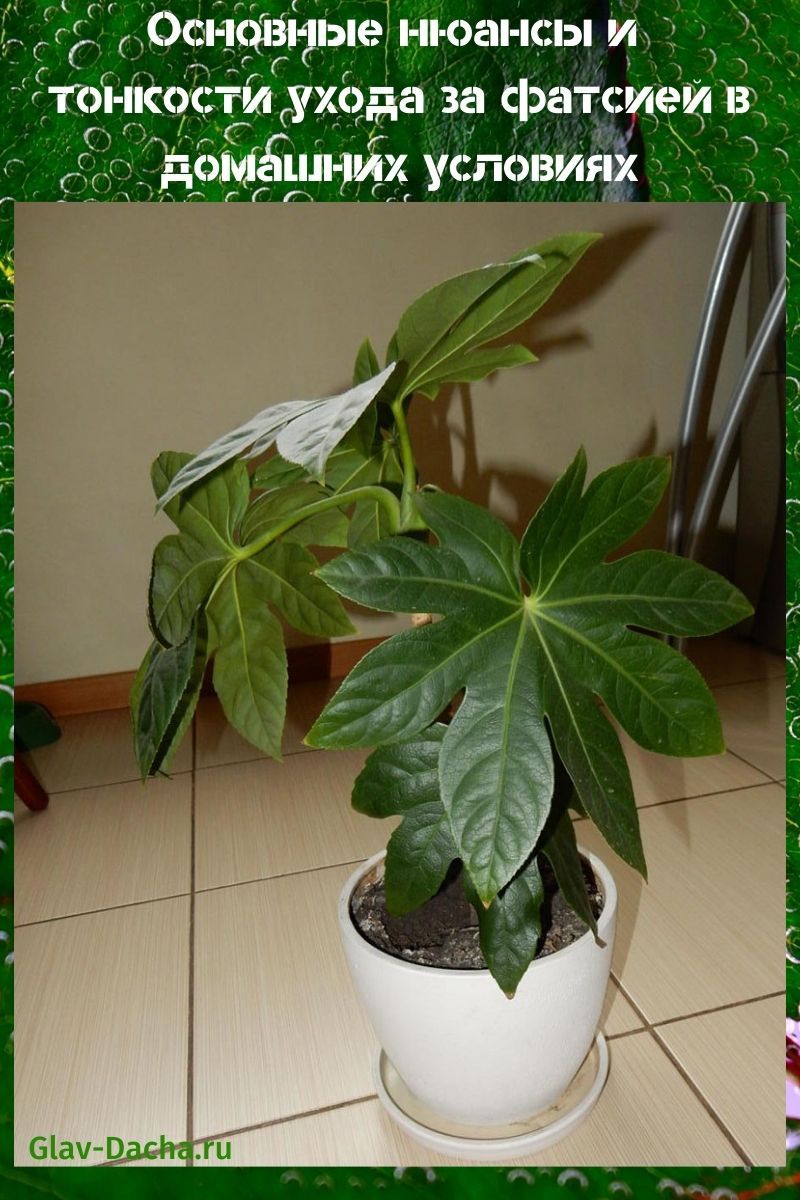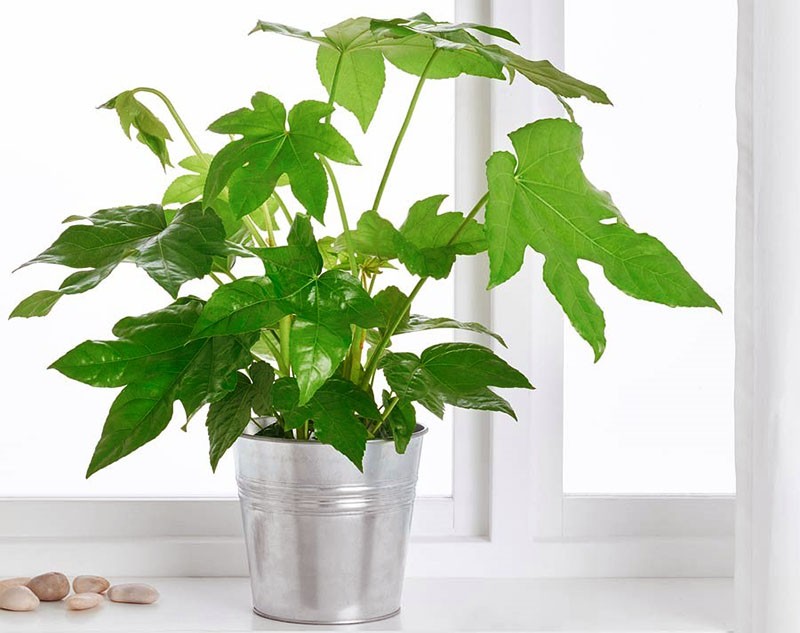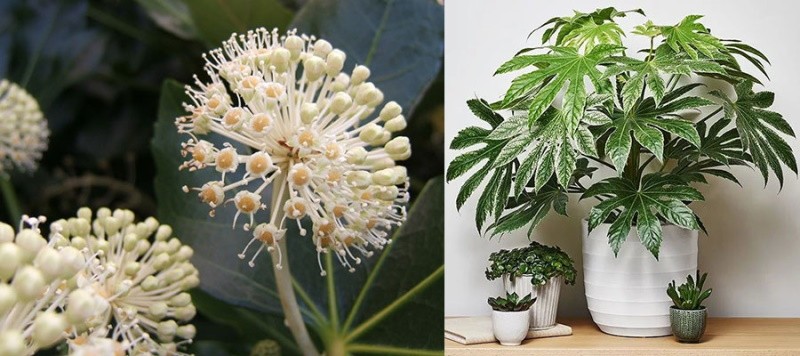The main nuances and subtleties of caring for Fatsia at home
 Fatsia is a beautiful, decorative leafy plant that is often used to decorate living rooms, hallways and other large spaces. Despite the unpretentious "character", caring for fatsia at home has several features. Considering these nuances, even a novice florist will be able to grow a slender and graceful plant that will become a bright decorative accent in any interior.
Fatsia is a beautiful, decorative leafy plant that is often used to decorate living rooms, hallways and other large spaces. Despite the unpretentious "character", caring for fatsia at home has several features. Considering these nuances, even a novice florist will be able to grow a slender and graceful plant that will become a bright decorative accent in any interior.
Botanical description of fatsia


The main features of Fatsia:
- When grown at home, Aralia reaches 1.5-2 m in height.
- The crown is massive and neat at the same time.
- The shoots are thin, which can not support the weight of lush foliage and need additional support.
- The leaves are large, up to 33-36 cm in diameter, dark green, neat and attractive. Form - heart-shaped or round, attached to the shoots with long petioles.
- The flowers are small, in the form of white panicles, consisting of many petals. Fatsia blooms are not particularly attractive, so they are grown as a deciduous plant.
With proper home care for Fatsia, its leaves acquire a spectacular glossy shine, becoming the main decoration of the plant.
Reproduction of fatsia
 Reproduction of Fatsia is carried out in three ways - cuttings, air layers and seeds. The most common and simplest is grafting. The optimal time for it is April-May.
Reproduction of Fatsia is carried out in three ways - cuttings, air layers and seeds. The most common and simplest is grafting. The optimal time for it is April-May.
To propagate from a large, healthy shoot, cut off a cutting with 3-4 swollen buds. Treat the cut of the cutting with a solution Kornevin or another stimulant. Prepare a soil mixture of peat and sand, moisten well and deepen the cutting to a depth of 2-3 cm.
Cover the stalk with plastic wrap or glass jar, creating a "greenhouse" environment for it. Remember to regularly water and ventilate the shoot. After 4-5 weeks, the first strong and healthy leaves appear on the shoot. After that, they can be transplanted in separate containers.
Propagation by air layers
 Experienced flower growers most often resort to propagating fatsia by air layers, since this method requires certain skills. In the spring, cut a sturdy shoot in a circle. Wrap the place of the incision with well-moistened sphagnum moss. Attach it with foil.
Experienced flower growers most often resort to propagating fatsia by air layers, since this method requires certain skills. In the spring, cut a sturdy shoot in a circle. Wrap the place of the incision with well-moistened sphagnum moss. Attach it with foil.
After that, the moss needs to be moistened again and the shoot is left in this form for 8-12 weeks. After this time, young roots appear in place of the moss. Cut the branch slightly below the roots and transplant it into a separate flower pot.
Seed propagation
 When growing fatsia from seeds, you can use both purchased and harvested planting material. It should be borne in mind that the germination of seeds is rapidly deteriorating, so sowing should be started immediately after collection.
When growing fatsia from seeds, you can use both purchased and harvested planting material. It should be borne in mind that the germination of seeds is rapidly deteriorating, so sowing should be started immediately after collection.
Sowing seeds:
- Pre-soak the seeds for a while in a solution of any growth stimulant.
- Prepare a loose and nutritious soil for growing.
- Spread the seeds evenly on the surface and sprinkle with a layer of soil about 1 cm thick.
- Sprinkle the crop with a spray bottle.
- Cover the seed container with glass or plastic wrap.
 Then move the container to a warm and well-lit place.
Then move the container to a warm and well-lit place.
After the first true leaves appear, the sprouts can be dived and planted in separate containers.
Fatsia care at home
 When caring for fatsia at home, it is very important to choose the right place for the location of the flower pot, provide it with the necessary air temperature, regular watering and feeding.
When caring for fatsia at home, it is very important to choose the right place for the location of the flower pot, provide it with the necessary air temperature, regular watering and feeding.
Fatsia belongs to light-loving plants, but it should not be placed in direct sunlight. It is best to place the flower on a windowsill on the east or west side. On summer days, the plant can be taken out into fresh air, but it must be protected from direct sunlight.
Temperature and humidity
 In the summer and spring of Fatsia, it is necessary to ensure an air temperature of 18-22 ° C. During the winter, the plant can be kept at room temperature, but it needs enough sunlight.
In the summer and spring of Fatsia, it is necessary to ensure an air temperature of 18-22 ° C. During the winter, the plant can be kept at room temperature, but it needs enough sunlight.
An indoor plant is very demanding on air humidity, which should be at least 50%.
 In dry air, the decorative attractiveness of fatsia is significantly reduced - the leaves lose their elasticity, their tips begin to dry and curl. To maintain the required moisture content, the plant can be irrigated with a spray bottle every 1-2 days.
In dry air, the decorative attractiveness of fatsia is significantly reduced - the leaves lose their elasticity, their tips begin to dry and curl. To maintain the required moisture content, the plant can be irrigated with a spray bottle every 1-2 days.
Watering
 Fatsia needs regular watering. In the warm season, the plant must be moistened as soon as the top layer of soil in the pot dries out by 1-2 cm.With the onset of September, the number of waterings should be reduced.
Fatsia needs regular watering. In the warm season, the plant must be moistened as soon as the top layer of soil in the pot dries out by 1-2 cm.With the onset of September, the number of waterings should be reduced.
In winter, the indoor flower needs to be watered very rarely. But you cannot completely stop moisturizing and let the earthy coma in the pot dry out completely.
Excess moisture is no less harmful to the plant - it can cause rotting of the root system and various diseases. Therefore, it is necessary to moisten the fatsia as the soil dries up.
Leaf care
Fatsia is grown as a deciduous plant, so its foliage needs special care to maintain its decorative appeal. The flower has large leaves that need to be regularly sprayed using settled water.
It is advisable to wipe the leaves of fatsia from time to time with a damp sponge - this will not only clean them of dust, but also maintain the necessary moisture.
In summer, you can arrange a kind of warm shower for the flower, while in winter you can reduce spraying.
Top dressing
 To maintain the decorative appeal and active growth of fatsia, a large amount of nutrients is needed. From April to October, the plant needs to be fed every week.
To maintain the decorative appeal and active growth of fatsia, a large amount of nutrients is needed. From April to October, the plant needs to be fed every week.
For this you can use like organicand special complex fertilizers for decorative deciduous crops. It is advisable to choose products with a high nitrogen content.
It is best to apply top dressing simultaneously with watering or immediately after it. In winter, fatsia does not need to be additionally fed.
Fatsia transplant
 Fatsia is a plant that needs to be transplanted no more than 1 time in 3-4 years, best of all in the first half of March. It tolerates this procedure very badly - it slowly adapts to a new place and can get sick. But at the same time, the root system of the flower grows very quickly and after a few years it ceases to fit in the old flower pot.
Fatsia is a plant that needs to be transplanted no more than 1 time in 3-4 years, best of all in the first half of March. It tolerates this procedure very badly - it slowly adapts to a new place and can get sick. But at the same time, the root system of the flower grows very quickly and after a few years it ceases to fit in the old flower pot.
When transplanting a plant, it is best to use the transshipment method, trying to preserve the soil lump. At the bottom of the container, you need to fill up drainage - small pebbles, crushed stone or expanded clay. Pour a mixture of turf, river sand, peat and humus on top of the drainage layer in a ratio of 2: 1: 1: 1.
After the transplant is completed, leave the container with fatcia in a shaded place and do not water for 4-5 days. Then slightly moisten the plant and transfer it to a permanent place.
 Fatsia is a beautiful and showy plant that is used for interior landscaping... This indoor flower is undemanding to care for; even a novice florist can grow it with a minimum of effort.
Fatsia is a beautiful and showy plant that is used for interior landscaping... This indoor flower is undemanding to care for; even a novice florist can grow it with a minimum of effort.